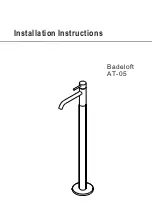
10
0
20
30
n
[1/min]
3000
4500
6000
7500
9000
[
h
Pa
]
Δ
p
ma
x
Fig. 2:
Max. permissible pressure differential between input and output sides, in accordance
with pump rotation speed
2.5 Proper use
► Use the vacuum pump for vacuum generation only.
► To protect the lubricant and the bearing, use sealing gas if high boiling, corrosive or particle-laden
media (e.g. solvents) are pumped.
► Operate the vacuum pump within the application limits of the product and in compliance with the
technical data.
► Adhere to the installation, commissioning, operating, and maintenance instructions.
► Use only accessory parts recommended by Pfeiffer Vacuum.
2.6 Foreseeable improper use
Improper use of the product invalidates all warranty and liability claims. Any use that is counter to the
purpose of the product, whether intentional or unintentional, is regarded as misuse.
● Pumping explosive media
● Pumping radioactive media
● Pumping media that can corrode or not be withstood by the vacuum pump materials
● Pumping media that introduce an ignition source to the suction chamber
● Pumping media that form adhesive deposits inside the suction chamber and cause the pistons to
touch or jam
● Pumping pressurized media (> atmospheric pressure)
● Pumping fluids that do not serve cleaning
● Pumping media prone to spontaneous, specific exothermic reactions
● Use in potentially explosive areas
● Use in systems in which sporadic loads and vibrations or periodic forces act on the device
● Use in strong electrical, magnetic, or electromagnetic fields
● Use with vacuum and/or fore-vacuum flange open to the atmosphere
● Modification of frequency converter parameters in the electronic drive unit
● Use of lubricants not specified by Pfeiffer Vacuum
● Use of pipes to lift the vacuum pump
● Use of accessories or spare parts not listed in these instructions
● Using the vacuum pump as a climbing aid
● Use of mineral-based lubricants, such as P3, with an oxygen concentration > 21 %
Mineral-based lubricants are combustible and ignite at high temperatures, and when they come
into contact with pure oxygen. These lubricants oxidize heavily and thus lose their lubricating ca-
pacity.
Safety
17/68
















































